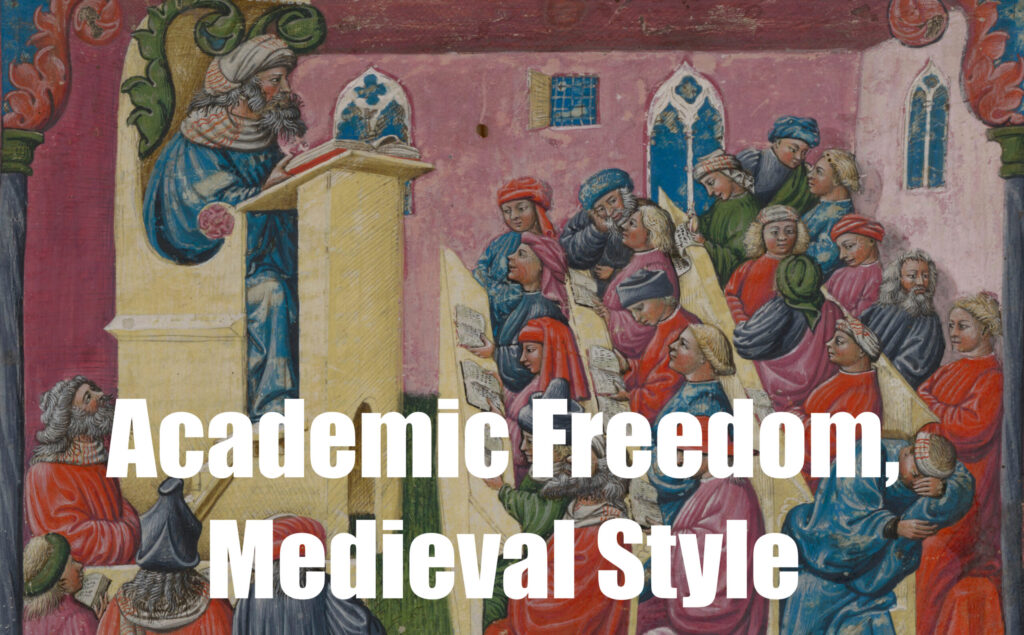Medieval universities were hotbeds of privilege, power, and the occasional riot—where students could get away with murder and still be protected by the Church. Today’s academic freedom debates may seem new, but they echo centuries-old struggles over who controls knowledge.
By Ken Mondschein
The Trump administration’s weaponization of anti-discrimination laws against anything redolent of “critical race theory” and hostility to higher education in general—including the $400 million blocked from Columbia University, Title VI investigations of 60 other schools, and foreign-born grad students being arrested for voicing political opinions—have been amply covered elsewhere. What we medievalists can add to the mix is some perspective on the historical independence of universities from politics—or the lack thereof.
The origins of academic freedom in the United States go back to a time when administrators and boards of trustees had almost absolute power to push their versions of the truth. Sometimes this was religious in nature: in 1877, a professor at Amherst College (then under the leadership of Julius Hawley Seelye, who was the college’s pastor as well as its president) was fired for teaching biology as a science, not divine creation.
As the Gilded Age pressed on, though, suppression of professors’ speech was increasingly based on differing political opinions. For instance, in 1896 economist Edward A. Ross of Stanford University criticized the railroad industry, from which the Stanford family had earned their fortune. Ross, along with seven other professors, wound up resigning from Stanford; one of these seven, Arthur Lovejoy, along with the educational theorist John Dewey of Columbia University, went on to found the American Association of University Professors. The AAUP’s 1915 Declaration of Principles on Academic Freedom and Academic Tenure was issued in response to these sorts of controversies.
While the AAUP’s Declaration cannot be separated from the nineteenth century’s ideas of professionalization and the rise of the professional academic expert, it also referenced two key principles: “the freedom of the teacher and… of the student, Lehrfreiheit and Lernfreiheit.” These intellectual imports from Germany were rooted in the Prussian philosopher and diplomat Wilhelm von Humboldt’s ideas about what education should be in general, and the university in particular. The “Humboldtian university,” with its emphasis on broad education, the unfettered production of new knowledge, and unbiased independence from the state and from commerce, became the basis for the modern research university.
While Humboldt’s conception of a secular and free university was rooted in the Enlightenment, medieval universities occupied quite a different place: though often independent from temporal authority or business interests—which were foremost of the AAUP’s concerns—they were not immune to the blowing of theological winds, which the AAUP mentioned as a concern of the past.
The nature of the first sort of independence was rooted in the raw exercise of power. A medieval university could and did exert considerable financial and political influence on its host town. For instance, the University of Paris’ strike from 1229–1231 after a riot between students and townsfolk put a not-insignificant strain on those whose livelihood depended on the students.
Second, the medieval university had authority and privileges that would be unheard of today. The papal edict that came out of the aforesaid incident, Gregory IX’s Parens Scientiarum, confirmed the university’s rights and independence from both local secular and ecclesiastical authorities, placed it under direct papal patronage, and added excommunication to the threats facing those who interfered with its functioning. (It may have helped the university’s case that Gregory himself was an alumnus.)
Most notable among these privileges was that medieval students and faculty were subject only to ecclesiastical law. Imagine, for a moment, a gaggle of rowdy undergraduates out drinking on the town—only instead of watching out for the police, the police were watching out for them, since any attempt to interfere with their fun might lead to excommunication! Likewise, imagine if the local police or even National Guard refused to risk their souls to quell a campus disturbance!
Medieval universities jealously guarded these privileges, even when it was contrary to good public relations or any notion of justice. To cite one egregious example from Paris, the aptly named Jean le Fourbeur (“the knave”) was accused of raping a jongleuse (that is, a public entertainer) named Symonette while on summer break in 1329. Symonette’s family complained to the bishop of Paris, Hugh de Bresançon, and Jean was imprisoned pending the payment of 400 livres. This quickly turned into a case of the university charging the bishop with ignoring the privileges of students and thus undermining papal authority. On April 5, 1331, Pope John XXII ordered the money to be returned—though half was given to the church of St. Victor, half to the university, and none returned to Jean!
This immunity extended even to homicide: In 1408, the prévôt (effectively, the mayor) of Paris had to personally cut down two students he had hanged for murder, kiss the corpses’ lips as an apology, and carry them in procession to the college’s main church. While students did not necessarily escape the consequences of their actions scot-free, the university would stand up for its own, especially in cases when doing nothing would undermine its status.
Similarly, in 1355, a fight broke out when a member of the University of Oxford beat a taverner who he felt had served him inferior wine. Such incidents were not uncommon—medieval Oxford’s murder rate was three times that of other towns, and roughly three-quarters of the victims and perpetrators were students—but this incident led to three days of rioting, with 30 townsmen and several dozen students being killed. Things did not end well for the townsfolk: Oxford was placed under an interdict by the Bishop of Lincoln and King Edward III fined the town, arrested its leaders, and gave the University a charter recognizing its rights over the town. Among other amends, the mayor of Oxford was compelled to do an annual penance in memory of the riot until the practice was finally discontinued in 1825.
Academic privileges and freedoms did not, however, extend to what could be taught. Violence was somewhat tolerated; heterodoxy less so. For instance, Amalric of Bena, a professor at Paris, was declared a heretic in 1206 for teaching pantheism—that God is everywhere. He died shortly after this condemnation, while ten of his followers were burned at the stake for heresy in 1210. Also related to this pantheistic controversy, an edict was issued in 1210 forbidding professors to teach Aristotle’s natural philosophy (that is, science). This ban was renewed by Gregory IX in 1228—the same pope who had championed the university’s political independence.
None of this, of course, stopped people from studying the banned books—for instance, there are ample commentaries on the Physics from the thirteenth century, and the University of Toulouse attempted to lure students away with the forbidden knowledge. But the authorities kept trying: in 1277, Étienne Tempier, Bishop of Paris, at the pope’s instigation, prohibited the teaching of 219 propositions that had been debated in the university. The seemingly nonsensical nature of these propositions, mostly derived from Aristotle’s natural philosophy—such as whether the universe could be accelerated in a straight line, leaving a vacuum behind—are immaterial. What was important was that they were deemed heretical because they put limits on God’s power, and thus were not open to debate.
Such restrictions were not limited to the Middle Ages. As my mini-history in the first few paragraphs indicated, theological condemnations never really ended, but continued well into the modern era—whether it was Darwinism that was suspect, or, as John Bennett Shank discusses in The Newton Wars, “Newtonianism” being seen in ancien régime France as cognate with dangerous democratic Enlightenment impulses. If anything, the Humboldtian university is the anomaly, a historical blip in the longer history of higher education.
We therefore need to see the Trump administration’s edicts in this longue durée. The current attack on academia is not that of a state cracking down on dissent, as happened in Mussolini’s Italy or Soviet Russia, since there is no real political ideology to go along with the suppression, no argument for re-ordering the world. Rather, much like the medieval Church, they are attempting to impose a negative weltanschauung—‘worldview’—upon rowdy intellectuals. Rather than detailing what must be said, they are merely condemning what they do not want said. (While the debate about the term “Anglo-Saxon” and other such controversies does, I’m afraid, put our discipline squarely on the Trumpian radar, thankfully, Medievalists.net is based in Canada.)
At least two things are different, however, from the Middle Ages. First, the Trump administration is trying to weaken, not build up, institutions. Second, and perhaps more significantly, the MAGA anti-academic turn signals a realignment of whose voice matters. As Chad Wellmon and other scholars have argued, the early 19th-century publishing boom and the ensuing proliferation of opinions led to the establishment of the Humboldtian university as a privileged site of the production of knowledge—the origins of academic publishing as we know it. Today, the Internet has similarly usurped traditional authority, and conspiracy theories, alternative facts, memes, and the musings of online trolls have replaced the—admittedly often moribund and doctrinaire—consensus of the academy.
Ken Mondschein is a scholar, writer, college professor, fencing master, and occasional jouster. Ken’s latest book is On Time: A History of Western Timekeeping. Click here to visit his website.
Click here to read more from Ken Mondschein
Top Image:
Subscribe to Medievalverse
Premium IPTV Experience with line4k
Experience the ultimate entertainment with our premium IPTV service. Watch your favorite channels, movies, and sports events in stunning 4K quality. Enjoy seamless streaming with zero buffering and access to over 10,000+ channels worldwide.

















